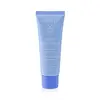What's inside
What's inside
 Key Ingredients
Key Ingredients

 Benefits
Benefits

 Concerns
Concerns

 Ingredients Side-by-side
Ingredients Side-by-side

Water
Skin ConditioningPropanediol
SolventC9-12 Alkane
SolventTriheptanoin
Skin ConditioningSilica
AbrasiveSodium Acrylates Copolymer
Sorbitol
HumectantPanthenol
Skin ConditioningMel
EmollientPropolis Extract
Skin ConditioningCistus Incanus Flower/Leaf/Stem Extract
Skin ConditioningIris Versicolor Extract
EmollientNymphaea Coerulea Flower Extract
Skin ConditioningNelumbo Nucifera Flower Extract
Skin ConditioningRosa Canina Fruit Extract
AstringentSodium Hyaluronate
HumectantAloe Barbadensis Leaf Juice Powder
Skin ConditioningHelianthus Annuus Seed Oil
EmollientRosa Damascena Flower Oil
MaskingCoco-Caprylate/Caprate
EmollientLecithin
EmollientGlycerin
HumectantTocopheryl Acetate
AntioxidantSaccharide Hydrolysate
HumectantTocopherol
AntioxidantEthylhexylglycerin
Skin ConditioningAllantoin
Skin ConditioningTetrasodium Glutamate Diacetate
Hydroxypropyl Cyclodextrin
MaskingHydroxyacetophenone
AntioxidantCitronellyl Methylcrotonate
MaskingParfum
MaskingGeraniol
PerfumingCitronellol
PerfumingLinalool
PerfumingLimonene
PerfumingWater, Propanediol, C9-12 Alkane, Triheptanoin, Silica, Sodium Acrylates Copolymer, Sorbitol, Panthenol, Mel, Propolis Extract, Cistus Incanus Flower/Leaf/Stem Extract, Iris Versicolor Extract, Nymphaea Coerulea Flower Extract, Nelumbo Nucifera Flower Extract, Rosa Canina Fruit Extract, Sodium Hyaluronate, Aloe Barbadensis Leaf Juice Powder, Helianthus Annuus Seed Oil, Rosa Damascena Flower Oil, Coco-Caprylate/Caprate, Lecithin, Glycerin, Tocopheryl Acetate, Saccharide Hydrolysate, Tocopherol, Ethylhexylglycerin, Allantoin, Tetrasodium Glutamate Diacetate, Hydroxypropyl Cyclodextrin, Hydroxyacetophenone, Citronellyl Methylcrotonate, Parfum, Geraniol, Citronellol, Linalool, Limonene
Water
Skin ConditioningGlycerin
HumectantPentylene Glycol
Skin ConditioningAcacia Senegal Gum
MaskingMalachite Extract
AntioxidantSuperoxide Dismutase
AntioxidantStevia Rebaudiana Leaf/Stem Extract
MaskingHyaluronic Acid
HumectantSodium Hyaluronate
HumectantAlthaea Officinalis Root Extract
Skin ConditioningGigartina Stellata Extract
Skin ProtectingSyringa Vulgaris Extract
Skin ConditioningLithothamnion Calcareum Extract
Skin ConditioningXanthan Gum
EmulsifyingAmylopectin
Parfum
MaskingChondrus Crispus Extract
Skin ConditioningMaltodextrin
AbsorbentLevulinic Acid
PerfumingSodium Levulinate
Skin ConditioningSodium Phytate
P-Anisic Acid
MaskingLactic Acid
BufferingSodium Hydroxide
BufferingSodium Benzoate
MaskingPotassium Sorbate
PreservativeCitric Acid
BufferingMaclura Cochinchinensis Leaf Prenylflavonoids
Water, Glycerin, Pentylene Glycol, Acacia Senegal Gum, Malachite Extract, Superoxide Dismutase, Stevia Rebaudiana Leaf/Stem Extract, Hyaluronic Acid, Sodium Hyaluronate, Althaea Officinalis Root Extract, Gigartina Stellata Extract, Syringa Vulgaris Extract, Lithothamnion Calcareum Extract, Xanthan Gum, Amylopectin, Parfum, Chondrus Crispus Extract, Maltodextrin, Levulinic Acid, Sodium Levulinate, Sodium Phytate, P-Anisic Acid, Lactic Acid, Sodium Hydroxide, Sodium Benzoate, Potassium Sorbate, Citric Acid, Maclura Cochinchinensis Leaf Prenylflavonoids
 Reviews
Reviews

Ingredients Explained
These ingredients are found in both products.
Ingredients higher up in an ingredient list are typically present in a larger amount.
Glycerin is already naturally found in your skin. It helps moisturize and protect your skin.
A study from 2016 found glycerin to be more effective as a humectant than AHAs and hyaluronic acid.
As a humectant, it helps the skin stay hydrated by pulling moisture to your skin. The low molecular weight of glycerin allows it to pull moisture into the deeper layers of your skin.
Hydrated skin improves your skin barrier; Your skin barrier helps protect against irritants and bacteria.
Glycerin has also been found to have antimicrobial and antiviral properties. Due to these properties, glycerin is often used in wound and burn treatments.
In cosmetics, glycerin is usually derived from plants such as soybean or palm. However, it can also be sourced from animals, such as tallow or animal fat.
This ingredient is organic, colorless, odorless, and non-toxic.
Glycerin is the name for this ingredient in American English. British English uses Glycerol/Glycerine.
Learn more about GlycerinParfum is a catch-all term for an ingredient or more that is used to give a scent to products.
Also called "fragrance", this ingredient can be a blend of hundreds of chemicals or plant oils. This means every product with "fragrance" or "parfum" in the ingredients list is a different mixture.
For instance, Habanolide is a proprietary trade name for a specific aroma chemical. When used as a fragrance ingredient in cosmetics, most aroma chemicals fall under the broad labeling category of “FRAGRANCE” or “PARFUM” according to EU and US regulations.
The term 'parfum' or 'fragrance' is not regulated in many countries. In many cases, it is up to the brand to define this term.
For instance, many brands choose to label themselves as "fragrance-free" because they are not using synthetic fragrances. However, their products may still contain ingredients such as essential oils that are considered a fragrance by INCI standards.
One example is Calendula flower extract. Calendula is an essential oil that still imparts a scent or 'fragrance'.
Depending on the blend, the ingredients in the mixture can cause allergies and sensitivities on the skin. Some ingredients that are known EU allergens include linalool and citronellol.
Parfum can also be used to mask or cover an unpleasant scent.
The bottom line is: not all fragrances/parfum/ingredients are created equally. If you are worried about fragrances, we recommend taking a closer look at an ingredient. And of course, we always recommend speaking with a professional.
Learn more about ParfumSodium Hyaluronate is hyaluronic acid's salt form. It is commonly derived from the sodium salt of hyaluronic acid.
Like hyaluronic acid, it is great at holding water and acts as a humectant. This makes it a great skin hydrating ingredient.
Sodium Hyaluronate is naturally occurring in our bodies and is mostly found in eye fluid and joints.
These are some other common types of Hyaluronic Acid:
Learn more about Sodium HyaluronateWater. It's the most common cosmetic ingredient of all. You'll usually see it at the top of ingredient lists, meaning that it makes up the largest part of the product.
So why is it so popular? Water most often acts as a solvent - this means that it helps dissolve other ingredients into the formulation.
You'll also recognize water as that liquid we all need to stay alive. If you see this, drink a glass of water. Stay hydrated!
Learn more about Water